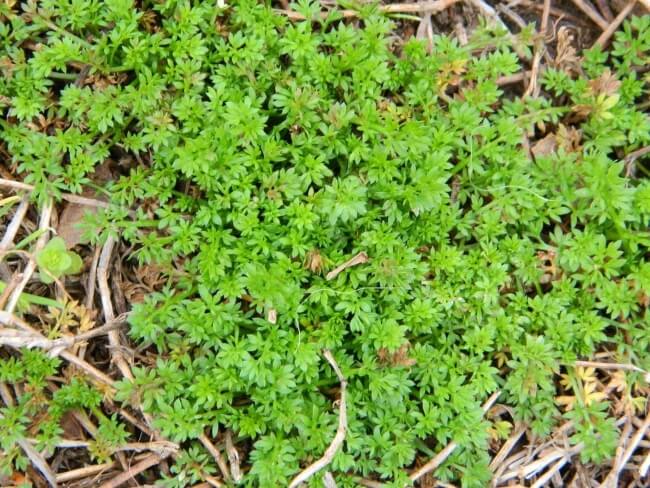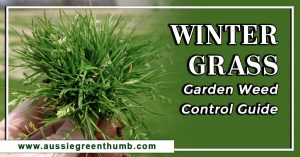Bindiis are hard to get rid of, but it’s far from impossible. We’ve battled them in our garden for years, but with a few tricks we learned recently (combined with some tried and tested classics) our lawn is looking better than ever.
If you’re searching for ways to get rid of bindiis, and coming to the end of your tether, then read through our guide, and banish the bindiis for good.
More...
Family: | Asteraceae |
|---|---|
Genus: | Soliva |
Species: | S. sessilis |
Common Names: | South America |
Origin: | Bindi weed, bindii, bindiis, lawnweed |
Location: | Outdoor |
Type: | Annual weed |
Growth: | 5 cm tall, 5-10 cm wide |
Sun requirements: | Full sun to shade |
Foliage Colour: | Green |
Flower Colour: | Yellow |
Flowering: | Spring to autumn |
Edible Parts: | None |
Maintenance level: | Low |
Poisonous for pets: | Non-toxic to cats and dogs |
What are Bindiis?
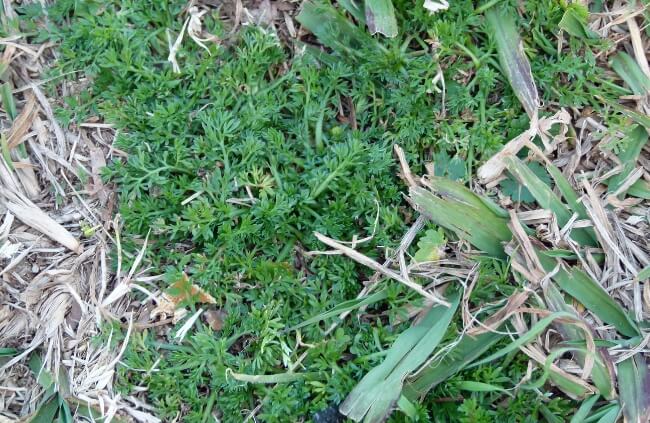
Soliva sessilis (formerly classified as Soliva pterosperma) are low-growing, mound-forming annual plants, with small yellow-green flowers, most commonly known in Australia as bindiis or bindi weeds. They look similar to chamomile, but with a denser habit, and grow low to the ground.
They can be found growing in all parts of your garden, but thrive in lawns where they are harder to spot until it’s too late. To identify bindiis, you need to look for a couple of identifying factors.
Firstly, bindiis look like moss, but if you squeeze them they won’t ooze out moisture like a sponge. Their leaves are frilled along short stems in a tight round rosette, usually growing in 5 cm clumps.
When they flower, their tiny yellow-green flowers have five even petals, which leave behind a green ring of sepals, which develops into a harshly spiked seed pod. Those spiky seed pods are how they move around the garden so effectively, by attaching to clothes and pet fur and then anchoring them into the soil.
On open soil, bindiis can spread out quite loosely, without the recognisable cushion form, but in lawns, they tend to grow as small cushions.
Bindii is native to South America, but is not firmly established in nearly all warmer regions of the world, including being endemic to Australia, where it is a distinctly invasive species.
Where do bindiis grow?
Bindiis are most commonly found in lawns, where they create patches of weeds with seed pods so spiky that it’s actually painful to walk across them barefoot.
However, they will grow quite happily in beds and borders, and between cracks in paving.
What conditions do bindiis prefer?
Bindiis grow on all soil types, and while they prefer to grow in full sun, can develop in shade just as well. While they can grow on all soils, they like compaction, so aerating your lawn will help to reduce their vigour.
As annuals, they need sunlight to develop, allowing your lawn to grow longer will limit development too.
How do bindiis grow and develop?
Bindiis are annual herbaceous plants, developing from seed into a mature plant in a single year. They are fast to flower and set seed, making them particularly hard to keep on top of, but individual plants can be pulled up to remove them.
Seeds germinate quickly, so pulling them regularly will halt their spread, and remove their chance of setting seed.


Get Your Free Guide:
Master Growing Australian Natives eBook
A Must Have Complete Guide for Every Australian Garden
Get Your Free Guide:
Master Growing Australian Natives eBook
A Must Have Complete Guide for Every Australian Garden
How to Get Rid of Bindiis
If you’re incredibly lucky, and you find a single bindii in your lawn, pulling it up could well prevent all others. However, in the history of gardening, no one has ever been that lucky.
The more realistic version, and the reality we’ve had since buying our house, is that bindiis will nearly always come back, because they seed into other gardens, and road sides, and can spread in all sorts of ways.
The most important thing with bindiis is perseverance. Like other thuggish weeds, you can get rid of them, but herbicides and pulling are only part of the salutation. Truly eradicating them takes a combination of efforts.
Step-by-Step Bindii Control
Firstly, get on top of the visible bindiis on your lawn. Before everything else, just remove what you can see. Then treat them with organic herbicides or homemade controls (both can be effective).
And once that’s done, get on top of your garden routine to prevent them from coming back.
1. Pulling bindiis out
Step one is simply removing any visible bindi weeds. Start by wetting your lawn. Don’t completely saturate it, but make sure the soil is slightly damp as it will make it easier to pull bindiis with their roots attached rather than leaving roots in the ground.
Now, get some thick trousers on, and good shoes to protect from scratching seeds. And then go out, get down on all fours, and pull out every single bindi you see. Pull smaller bindiis by pinching them out, and tease larger bindiis out with a screwdriver, a weed puller, or similar tool to tease them out of the lawn without damaging the grass around them.
Throw everything straight in the bin, and make sure you don’t drop any seeds as you go.
2. Killing bindiis quickly
Obviously, for larger lawns, the first step is challenging, but it’s worth it. Next, you’ll need to work on some control methods. Wait a week after pulling your visible bindiis, and then check again, if any have come back, either repeat the pulling process or treat them with herbicides.
What works for us are organic, selective, herbicides. There are plenty of brands, and they mostly work just as well as each other, but we’ve put together a list of some of the ones we found to be most effective below.
Chemical herbicides can be effective, but most of what we’ve tried has done damage to the lawn and left areas more exposed for bindiis to come back. Organics might be gentler, but they create better natural conditions for suppression too.
Make sure whatever you use is selective and won’t harm your grass, and avoid glyphosate at all costs. Not only does it smell awful, it’s an incredibly powerful herbicide that will harm your lawn, and travel on light winds around the garden, causing harm to plants and wildlife.
3. Quick lawn care hacks to slow down bindiis
Now, that you’ve treated the lawn there will still be seeds left over. To stop them from germinating, you can use nature to your advantage. By far the most effective thing we’ve done to get rid of bindiis is to let our lawn grow longer.
Bindiis need sunlight, and hate competition. Their seeds just don’t germinate, and because they are low-growing, they can’t photosynthesise effectively under the shade of taller grass.
Go half way on this by simply increasing your lawn mower blade height, or go the whole hog as we did, and leave your lawn to grow up into a basic meadow from late spring to mid-summer.
This is the latest trick we tried, and with just a few months of longer lawn, the reduction in bindiis this year has been incredible. We’ll repeat this again in late spring.
Note: When you cut your lawn back, it will take a few weeks to recover, but it’s worth it
Weed Killer for Getting Rid of Bindiis
1. Richgro Beat-A-Weed Natural Weed Killer
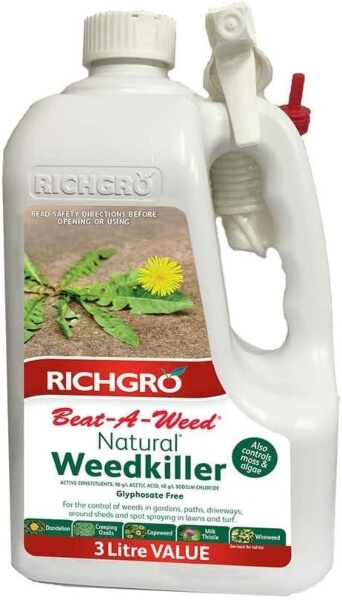
Richgro’s organic, glyphosate-free, weed killer is effective on bindi top growth and roots. It has little effect on seeds, but is easy to apply with a hand spray attachment.
A word of caution about Beat-A-Weed is that it will damage your lawn in patches, but without permanent harm. After 24 hours, water your lawn well to remove any residual weed killer and it should recover in a week.
More on weed killers: Choosing the Right Weed Killer for Your Garden
Bindi Control Tips to Avoid
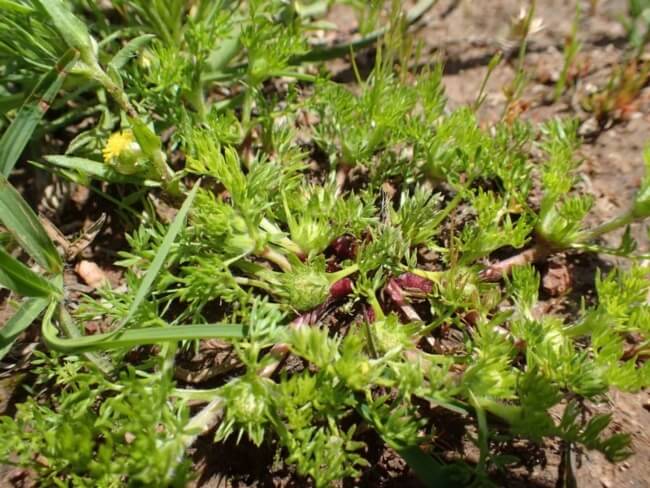
Source: Canberra Nature Map - NatureMapr
There are three really common bindi control hacks that keep coming up, and not only are they ineffective but they can actively harm the rest of your garden.
Firstly, vinegar and salt. Both are harmful to plants by themselves, and can leave lasting damage to soil health. If you are treating bindiis on a patio, this will work to kill visible plants, but won’t deal with any dropped seeds.
Next up, boiling water. Boiling water doesn’t do any lasting damage to your garden, but it also doesn’t do much to bindiis either. It will weaken developed plants, but these are annual needs, so they are resilient enough to come back from water, and (again), it won’t do anything to the seeds.
And finally, the old school herbicide, used for generations around the world… glyphosate. It’s an incredibly effective weed killer, but it’s also an incredibly effective animal killer. It’s toxic to pets, humans and insects, and any drift on the wind will harm nearby plants too.
And just like any other quick control method for bindiis, if used alone, it won’t have any lasting impact on their spread if they have dropped seeds already.
Frequently Asked Questions About Bindiis

Source: Lawn Solutions Australia
What’s the easiest way to get rid of bindi weeds?
There is no easy way to get rid of bindi weeds, but if you don’t want to pull them out individually, or temporarily allow your grass to grow long, iron sulphate is a useful bindi killer that can feed your lawn if not over-applied.
What time of year should you spray bindi?
The best time of year to spray bindi is in spring, followed by a summer of other checks and controls. This weakens the plant before it really kicks into flowering to limit seed production.
Does vinegar kill bindiis?
A mixture of vinegar and salt will kill bindiis quickly, but it will also harm nearby plants, and remain in the soil.
Do bindiis sting?
Bindi does not sting, but its sharp seeds penetrate skin and cause bleeding. In large numbers they can be incredibly harmful to anyone walking on your lawn with bare feet.
Wrapping Up Guide to Getting Rid of Bindiis in Your Lawn
Bindi weeds are a nightmare if you find them in your garden, and what makes it worse is that they’re not even native to Australia. But with a little bit of patience, and a willingness to try something different, you can get rid of them.
It’s a dedicated task, but well worth doing, and next year you’ll be able to enjoy a bindii-free lawn.
Published on October 5, 2023 by Gary Clarke
Last Updated on October 9, 2025

